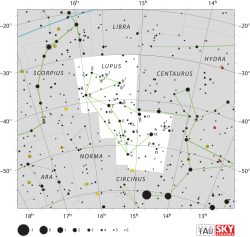Jota Lupi
| Jota Lupi (ι) | |
 | |
| Observationsdata Epok: J2000 | |
|---|---|
| Stjärnbild | Vargen |
| Rektascension | 14t 19m 24,22219s[1] |
| Deklination | -46° 03′ 29,1437″[1] |
| Skenbar magnitud () | 3,54[2] |
| Stjärntyp | |
| Spektraltyp | B2.5 IV[3] |
| U–B | -0,742[2] |
| B–V | -0,180[2] |
| Astrometri | |
| Radialhastighet () | +21,6 ± 4,1[4] km/s |
| Egenrörelse (µ) | RA: -12,56[1] mas/år Dek.: -4,76[1] mas/år |
| Parallax () | 9,65 ± 0,20[1] |
| Avstånd | 338 ± 7 lå (104 ± 2 pc) |
| Absolut magnitud () | -1,48[5] |
| Detaljer | |
| Massa | 6,9 ± 0,1[6] M☉ |
| Radie | 4,05 ± 0,33[7] R☉ |
| Luminositet | 2 082[8] L☉ |
| Temperatur | 18 605 ± 221[7] K |
| Metallicitet | +0,19 ± 0,15[7] |
| Vinkelhastighet | 370[9] |
| Ålder | 20,3 ± 4,8[6] miljoner år |
| Andra beteckningar | |
| ι Lup, CD-45° 9084, HD 125238, HIP 69996, HR 5354, SAO 224833.[10] | |
Jota Lupi (ι Lupi, förkortad Jota Lup, ι Lup), som är stjärnans Bayer-beteckning, är en ensam stjärna[11] i västra delen av stjärnbilden Vargen. Den har en skenbar magnitud av 3,54[2] och är synlig för blotta ögat där ljusföroreningar ej förekommer. Baserat på parallaxmätning inom Hipparcosuppdraget på ca 9,7 mas,[1] beräknas den befinna sig på ett avstånd av ca 340 ljusår (104 parsek) från solen. På det beräknade avståndet minskar stjärnans skenbara magnitud med en skymningsfaktor på 0,23 enheter beroende på interstellärt stoft.[5] Stjärnan verkar ingå i Scorpio-Centaurus OB-gruppen.[12]
Egenskaper
[redigera | redigera wikitext]Jota Lupi är en blå till vit underjättestjärna av spektralklass B2.5 IV,[3], vilket kan tyda på att den har förbrukat sitt förråd av väte och har börjat expandera från huvudserien. Den har en massa som är ca 7[6] gånger solens massa, en radie som är ca 4[7] gånger solens radie och avger ca 2 100[8] gånger mer energi än solen från dess fotosfär vid en effektiv temperatur på ca 18 600 K.[7]
Jota Lupi roterar snabbt med en projicerad rotationshastighet på 370 km/s,[9] vilket ger den en något tillplattad form med en ekvatorialradie som uppskattas vara 12 procent större än polarradien.[13]
Referenser
[redigera | redigera wikitext]- Den här artikeln är helt eller delvis baserad på material från engelskspråkiga Wikipedia, 28 januari 2019.
Noter
[redigera | redigera wikitext]- ^ [a b c d e f] van Leeuwen, F. (2007), "Validation of the new Hipparcos reduction", Astronomy and Astrophysics, 474 (2): 653–664, arXiv:0708.1752, Bibcode:2007A&A...474..653V, doi:10.1051/0004-6361:20078357.
- ^ [a b c d] Gutierrez-Moreno, Adelina; Moreno, Hugo (June 1968), "A photometric investigation of the Scorpio-Centaurus association", Astrophysical Journal Supplement, 15: 459, Bibcode:1968ApJS...15..459G, doi:10.1086/190168.
- ^ [a b] Hiltner, W. A.; et al. (July 1969), "MK Spectral Types for Bright Southern OB Stars", Astrophysical Journal, 157: 313–326, Bibcode:1969ApJ...157..313H, doi:10.1086/150069.
- ^ de Bruijne, J. H. J.; Eilers, A.-C. (October 2012), "Radial velocities for the HIPPARCOS-Gaia Hundred-Thousand-Proper-Motion project", Astronomy & Astrophysics, 546: 14, arXiv:1208.3048, Bibcode:2012A&A...546A..61D, doi:10.1051/0004-6361/201219219, A61.
- ^ [a b] Gontcharov, G. A. (November 2012), "Spatial distribution and kinematics of OB stars", Astronomy Letters, 38 (11): 694–706, arXiv:1606.09028, Bibcode:2012AstL...38..694G, doi:10.1134/S1063773712110035.
- ^ [a b c] Tetzlaff, N.; et al. (January 2011), "A catalogue of young runaway Hipparcos stars within 3 kpc from the Sun", Monthly Notices of the Royal Astronomical Society, 410 (1): 190–200, arXiv:1007.4883, Bibcode:2011MNRAS.410..190T, doi:10.1111/j.1365-2966.2010.17434.x.
- ^ [a b c d e] Fitzpatrick, E. L.; Massa, D. (March 2005), "Determining the Physical Properties of the B Stars. II. Calibration of Synthetic Photometry", The Astronomical Journal, 129 (3): 1642–1662, arXiv:astro-ph/0412542, Bibcode:2005AJ....129.1642F, doi:10.1086/427855.
- ^ [a b] Hohle, M. M.; et al. (April 2010), "Masses and luminosities of O- and B-type stars and red supergiants", Astronomische Nachrichten, 331 (4): 349, arXiv:1003.2335, Bibcode:2010AN....331..349H, doi:10.1002/asna.200911355.
- ^ [a b] Uesugi, Akira; Fukuda, Ichiro (1970), "Catalogue of rotational velocities of the stars", Contributions from the Institute of Astrophysics and Kwasan Observatory, University of Kyoto, Bibcode:1970crvs.book.....U.
- ^ "iot Lup -- Variable Star", SIMBAD Astronomical Database, Centre de Données astronomiques de Strasbourg, hämtad 2017-03-05.
- ^ Eggleton, P. P.; Tokovinin, A. A. (September 2008), "A catalogue of multiplicity among bright stellar systems", Monthly Notices of the Royal Astronomical Society, 389 (2): 869–879, arXiv:0806.2878, Bibcode:2008MNRAS.389..869E, doi:10.1111/j.1365-2966.2008.13596.x.
- ^ de Geus, E. J.; et al. (June 1989), "Physical parameters of stars in the Scorpio-Centaurus OB association", Astronomy and Astrophysics, 216 (1–2): 44–61, Bibcode:1989A&A...216...44D.
- ^ Belle, G. T. (2012), "Interferometric observations of rapidly rotating stars", The Astronomy and Astrophysics Review, 20: 51, arXiv:1204.2572, Bibcode:2012A&ARv..20...51V, doi:10.1007/s00159-012-0051-2.





